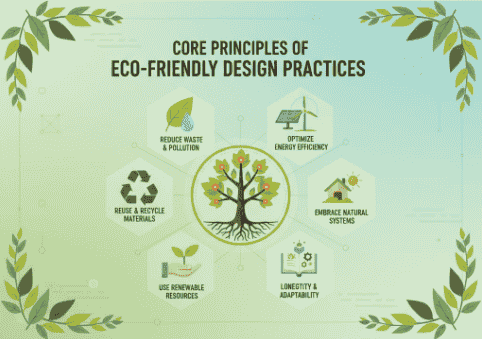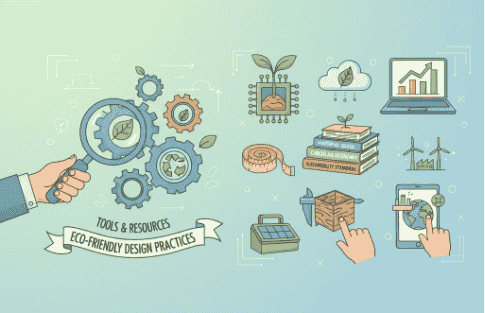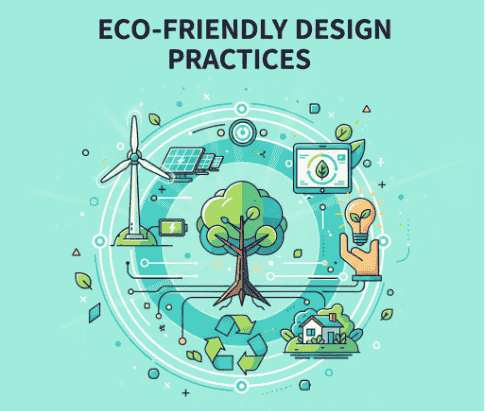Table of Contents
- Introduction: Why Eco Friendly Design Practices Matter
- Core Principles of Eco Friendly Design Practices
- Eco Friendly Design Practices in Graphic Design
- Sustainable Typography: Fonts for Eco Friendly Design Practices
- Digital-First vs. Print: Eco Friendly Design Practices for Modern Creatives
- Tools and Resources for Eco Friendly Design Practices
- Real-World Examples of Eco Friendly Design Practices
- Using RaisProject Fonts to Support Eco Friendly Design Practices
- Conclusion: The Future of Eco Friendly Design Practices
- References
1. Introduction: Why Eco Friendly Design Practices Matter
The creative industry has an undeniable impact on the environment. Every printed flyer, oversized billboard, and product packaging contributes to waste, carbon emissions, and resource depletion. As society becomes increasingly eco-conscious, designers face a growing responsibility to adapt their processes.
Eco friendly design practices are not just a trend; they are a necessity for businesses and individuals who want to remain relevant and responsible. A survey by Adobe revealed that over 60% of consumers are more likely to support brands that demonstrate a commitment to sustainability. For designers, this means eco-friendly choices are not only better for the planet—they can also increase client trust, build long-term loyalty, and strengthen a brand’s reputation.
By implementing eco friendly design practices, creatives can become leaders in shaping a sustainable future while still producing innovative and engaging work.
2. Core Principles of Eco Friendly Design Practices
To design sustainably, one must first understand the foundation of eco friendly design practices. These principles can guide professionals across industries, ensuring that every creative decision is aligned with environmental responsibility:
- Reduce Waste: Focus on designs that use fewer resources. In print, this may mean reducing excess space, limiting unnecessary layers, or combining multiple design purposes into one asset.
- Use Sustainable Materials: Choose recycled paper, biodegradable packaging, and eco-friendly inks whenever possible. This not only reduces waste but also encourages suppliers to adopt greener production methods.
- Prioritize Digital-First Solutions: Opt for digital distribution—social media graphics, e-books, newsletters, and online campaigns—before print. Digital-first content minimizes paper and ink use.
- Design for Longevity: Timeless, minimalist designs reduce the need for frequent reprints or redesigns, saving both resources and time.

The Environmental Protection Agency (EPA) emphasizes that responsible design choices, when multiplied across industries, play a significant role in sustainable material management.
3. Eco Friendly Design Practices in Graphic Design
Graphic design has historically been resource-heavy. From physical advertising campaigns to direct mail promotions, the reliance on print media has contributed significantly to waste. Today, designers have more options than ever to rethink their approach.
Adopting eco friendly design practices in graphic design means shifting toward sustainability at every stage:
- Using digital mockups instead of printed proofs.
- Creating multipurpose assets that work across platforms (e.g., the same design optimized for social media, email, and websites).
- Incorporating nature-inspired visuals to connect with eco-conscious audiences authentically.
The World Wildlife Fund (WWF) highlights reducing unnecessary paper use as one of the most direct ways to make design more sustainable. For designers, this could mean suggesting digital campaigns instead of mass-print promotions to clients.
4. Sustainable Typography: Fonts for Eco Friendly Design Practices
Typography is often overlooked in conversations about sustainability, but it plays a crucial role. Fonts affect not only the aesthetics of a project but also the environmental cost, especially in print.
- Lightweight Fonts: Thin, minimalist fonts consume less ink during printing.
- Readable Digital Fonts: Optimized screen fonts reduce the need for reprints caused by poor legibility.
- Nature-Inspired Fonts: These visually reinforce eco-friendly messages in branding.
At RaisProject, we offer fonts that align perfectly with sustainable design goals:
- Gendisa Display Font – Elegant, digital-first typography that enhances readability.
- Natural Forest Font – Organic and nature-inspired, ideal for eco-conscious branding.
- Damention Sans Serif Font – Lightweight, clean, and efficient for both print and digital use.
These fonts not only reflect the values of sustainability but also allow designers to communicate eco-conscious branding effectively.
5. Digital-First vs. Print: Eco Friendly Design Practices for Modern Creatives
Shifting to a digital-first approach is one of the most impactful eco friendly design practices for creatives. Digital design offers flexibility, scalability, and reach without contributing to physical waste.
Benefits of digital-first design include:
- Lower Environmental Impact: Reduced need for paper, ink, and shipping.
- Accessibility: Digital content can be accessed globally without material limitations.
- Repurposability: Designs can be easily resized, reformatted, and reused.
When print is unavoidable, eco-friendly strategies can still minimize harm:
- Print smaller batches.
- Use soy-based or vegetable inks.
- Choose FSC-certified or recycled papers.
- Maximize layouts to reduce paper waste.
As the Sustainable Web Manifesto states, creating energy-efficient and low-carbon digital products is the future of sustainable design.
6. Tools and Resources for Eco Friendly Design Practices
Designers do not have to work alone in this transition. Several tools and resources help professionals evaluate and reduce the environmental impact of their projects:
- Sustainable Web Manifesto – A pledge for digital designers to create low-energy, sustainable online products.
- Website Carbon Calculator – An online tool that measures the carbon footprint of a website.
- Ecofont – A typeface engineered to use less ink without sacrificing readability.
- Sustainable Packaging Guidelines – Many organizations now publish open-source resources to help designers choose eco-friendly packaging materials.
By leveraging these resources, designers can make informed decisions and align their work with sustainability standards.

7. Real-World Examples of Eco Friendly Design Practices
The best way to understand the value of sustainable design is by looking at brands that have successfully implemented eco friendly design practices:
- IKEA shifted its catalog from print to digital, saving massive amounts of paper and lowering its carbon footprint (IKEA Sustainability Report).
- Patagonia uses minimalist, recyclable packaging and promotes a “reduce, repair, recycle” approach in both design and branding (Patagonia Environmental Responsibility).
- Digital Campaigns at major events now replace printed posters, reducing waste while increasing global reach.
These case studies prove that eco friendly design practices are not only achievable but also beneficial for business growth.
8. Using RaisProject Fonts to Support Eco Friendly Design Practices
Typography has the power to shape perception, and choosing the right font can reinforce a brand’s eco-friendly identity. Fonts from RaisProject are designed to help creatives align their work with sustainability while maintaining high-quality aesthetics.
Some excellent options include:
- Zarla Sans Serif Font – Clean and natural, ideal for eco-conscious brands.
- Rashyed Handwriting Font – Handwritten style that emphasizes authenticity and nature-inspired design.
- Ice Drink Sans Serif Font – Perfect for timeless, print-friendly designs that reduce waste.
By integrating these fonts, designers can amplify eco friendly design practices while maintaining professional and creative excellence.
9. Conclusion: The Future of Eco Friendly Design Practices
Eco friendly design practices are the future of creative industries. They allow designers to balance innovation, client expectations, and environmental responsibility. By reducing waste, embracing digital-first approaches, and choosing sustainable typography, creatives can deliver designs that not only look good but also do good.
Sustainability is no longer optional; it is a creative imperative. As brands and consumers continue to demand eco-conscious solutions, designers who adapt now will lead the way toward a greener future.
For creatives looking to take the next step, RaisProject Fonts provides eco-conscious typography choices that support sustainable branding and design goals.
10. References
- Adobe Blog – Designing a Sustainable Future
- EPA – Sustainable Management of Materials
- WWF – The Green Guide
- Sustainable Web Manifesto – Official Website
- Website Carbon Calculator – Calculate Website Footprint
- Ecofont – Eco-Friendly Typeface
- IKEA – Sustainability Report
- Patagonia – Environmental Responsibility

